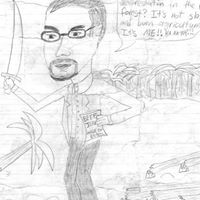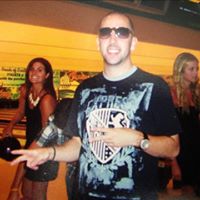Nicholas N Nagle
age ~47
from Oak Ridge, TN
- Also known as:
-
- Nicholas Nathaniel Nagle
- Nick N Nagle
- Nichlas Nagle
- Nocholas Nagle
- Phone and address:
-
204 Connors Cir, Oak Ridge, TN 37830
(530)7572062
Nicholas Nagle Phones & Addresses
- 204 Connors Cir, Oak Ridge, TN 37830 • (530)7572062
- 1624 Capitol Blvd, Knoxville, TN 37931 • (865)6926778
- 2024 Gyros Cir, Lafayette, CO 80026 • (720)8908663
- Boulder, CO
- Goleta, CA
- Davis, CA
- Woodstock, IL
- Simi Valley, CA
- Mina, NV
- Silver City, NV
- 204 Connors Cir, Oak Ridge, TN 37830
Work
-
Company:University of tennesseeAug 1, 2015
-
Position:Associate professor of geography
Education
-
Degree:Doctorates, Masters, Master of Arts, Doctor of Philosophy
-
School / High School:Uc Santa Barbara1999 to 2005
-
Specialities:Economics, Philosophy, Geography
Skills
Geographic Information Science • Statistics • Spatial Analysis • Demography • Research • Higher Education • University Teaching • Data Analysis • Statistical Modeling
Industries
Higher Education
Resumes

Associate Professor Of Geography
view sourceLocation:
Knoxville, TN
Industry:
Higher Education
Work:
University of Tennessee
Associate Professor of Geography
University of Tennessee 2010 - Jul 2015
Assistant Professor
Associate Professor of Geography
University of Tennessee 2010 - Jul 2015
Assistant Professor
Education:
Uc Santa Barbara 1999 - 2005
Doctorates, Masters, Master of Arts, Doctor of Philosophy, Economics, Philosophy, Geography University of Chicago 1996 - 1999
Bachelors, Bachelor of Arts, Public Policy University of California
Doctorates, Masters, Master of Arts, Doctor of Philosophy, Economics, Philosophy, Geography University of Chicago 1996 - 1999
Bachelors, Bachelor of Arts, Public Policy University of California
Skills:
Geographic Information Science
Statistics
Spatial Analysis
Demography
Research
Higher Education
University Teaching
Data Analysis
Statistical Modeling
Statistics
Spatial Analysis
Demography
Research
Higher Education
University Teaching
Data Analysis
Statistical Modeling
Us Patents
-
Process For The Conversion Of And Aqueous Biomass Hydrolyzate Into Fuels Or Chemicals By The Selective Removal Of Fermentation Inhibitors
view source -
US Patent:6737258, May 18, 2004
-
Filed:Jan 11, 2002
-
Appl. No.:10/031216
-
Inventors:Bonnie R. Hames - Westminster CO
Amie D. Sluiter - Arvada CO
Tammy K. Hayward - Broomfield CO
Nicholas J. Nagle - Broomfield CO -
Assignee:Midwest Research Institute - Kansas City MO
-
International Classification:C12P 706
-
US Classification:435161, 435162, 435163, 435165, 4352521, 4352529, 4352536, 4352551, 4352552, 43525521
-
Abstract:A process of making a fuel or chemical from a biomass hydrolyzate is provided which comprises the steps of providing a biomass hydrolyzate, adjusting the pH of the hydrolyzate, contacting a metal oxide having an affinity for guaiacyl or syringyl functional groups, or both and the hydrolyzate for a time sufficient to form an adsorption complex; removing the complex wherein a sugar fraction is provided, and converting the sugar fraction to fuels or chemicals using a microorganism.
-
Pretreatment Of High Solid Microbial Sludges
view source -
US Patent:57858527, Jul 28, 1998
-
Filed:Apr 6, 1995
-
Appl. No.:8/418592
-
Inventors:Christopher J. Rivard - Lakewood CO
Nicholas J. Nagle - Broomfield CO -
Assignee:Midwest Research Institute - Kansas City MI
-
International Classification:C02F 1118
-
US Classification:210613
-
Abstract:A process and apparatus for pretreating microbial sludges in order to enhance secondary anaerobic digestion. The pretreatment process involves disrupting the cellular integrity of municipal sewage sludge through a combination of thermal, explosive decompression and shear forces. The sludge is pressurized and pumped to a pretreatment reactor where it is mixed with steam to heat and soften the sludge. The pressure of the sludge is suddenly reduced and explosive decompression forces are imparted which partially disrupt the cellular integrity of the sludge. Shear forces are then applied to the sludge to further disrupt the cellular integrity of the sludge. Disrupting cellular integrity releases both soluble and insoluble organic constituents and thereby renders municipal sewage sludge more amenable to secondary anaerobic digestion.
-
Pretreatment Of Microbial Sludges
view source -
US Patent:53804457, Jan 10, 1995
-
Filed:Oct 22, 1993
-
Appl. No.:8/139840
-
Inventors:Christopher J. Rivard - Lakewood CO
Nicholas J. Nagle - Louisville CO -
Assignee:Midwest Research Institute - Kansas City MO
-
International Classification:C02F 136
-
US Classification:210748
-
Abstract:Methods are described for pretreating microbial sludges to break cells and disrupt organic matter. One method involves the use of sonication, and another method involves the use of shear forces. The pretreatment of sludge enhances bioconversion of the organic fraction. This allows for efficient dewatering of the sludge and reduces the cost for final disposal of the waste.
Classmates

Nicholas Nagle
view sourceSchools:
Ridgewood High School West Lafayette OH 2000-2004
Community:
Steve Amore, Shelly Hains, Patti Stanley

Nicholas Nagle
view sourceSchools:
Saint Bernard School Dayton KY 1953-1959, Edgewood Junior High School Merritt Island FL 1959-1961
Community:
Patsy Gray, Jim Flowers

Saint Bernard School, Day...
view sourceGraduates:
Lawrence Ries (1946-1952),
Della Caudill (1955-1963),
Mary Fieler (1947-1955),
Nicholas Nagle (1953-1959)
Della Caudill (1955-1963),
Mary Fieler (1947-1955),
Nicholas Nagle (1953-1959)

Ridgewood High School, We...
view sourceGraduates:
April Miller (1993-1997),
Nicholas Nagle (2000-2004),
Suzanne Merritt (1981-1985),
Rocky Rocky Lee Bridges (1983-1987)
Nicholas Nagle (2000-2004),
Suzanne Merritt (1981-1985),
Rocky Rocky Lee Bridges (1983-1987)

St. John's River Communit...
view sourceGraduates:
Nicholas Nagle (1996-1998),
Pamela Mentzer (1990-1992),
Scott Markowitz (1991-1993),
Joe Saucier (1997-1999)
Pamela Mentzer (1990-1992),
Scott Markowitz (1991-1993),
Joe Saucier (1997-1999)

Edgewood Junior High Scho...
view sourceGraduates:
Nicholas Nagle (1959-1961),
Cathlyn Smith (1977-1981),
Edward Baker (1968-1971),
Greg Van Nattan (1968-1971)
Cathlyn Smith (1977-1981),
Edward Baker (1968-1971),
Greg Van Nattan (1968-1971)

Nick Nagle
view source
Nicholas Nagle
view source
Nick Nagle
view source
Nicholas Nagle
view source
Nicholas Nagle
view source
Nicholas Nagle
view source
Nicholas Nagle
view sourceMyspace
Youtube
Googleplus

Nicholas Nagle

Nicholas Nagle
Work:
University of Tennessee
Flickr
Get Report for Nicholas N Nagle from Oak Ridge, TN, age ~47












